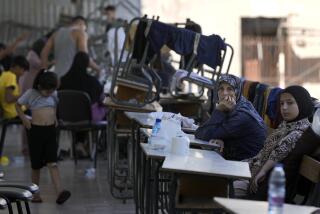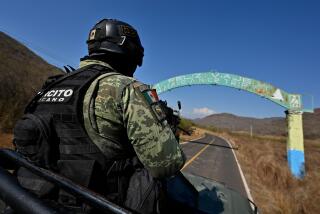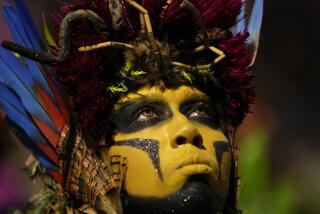In Libya minefields, ill-equipped rebel teams defuse devices
Reporting from Ajdabiya, Libya — He searches for land mines, but he has no body armor or protective mask, no metal detector, no steel-toed boots. He wears dress shoes. His tools are a metal prod and an old rake.
Salem Barassi is a weathered former police officer, 67 and long retired. He’s one of dozens of volunteers who clear mines at Libya’s fighting fronts, using their bare hands to lift hundreds of small antipersonnel mines laid by forces loyal to Libyan leader Moammar Kadafi.
Every morning, Barassi tiptoes into minefields outside the eastern Libyan oil city of Port Brega. Prodding the sand with his probe and clearing debris with the rake, he inches forward, taking tiny, measured steps.
When the probe strikes a buried object, Barassi stoops to clear away the sand. Several times a day, he uncovers a Brazilian-made mine, constructed of tan plastic, that’s small enough to hold in the palm of his hand. Each mine is stamped, in English: “High Explosive.”
“You have to use a very soft touch to remove these things,” he says. “Otherwise, you’ll set them off, and boom!”
He carefully lifts the mine and unscrews its fuse. Mines and fuses are placed in discarded ammunition boxes for safekeeping: 54 mines collected on this brutally hot summer day by Barassi and other members of his team.
Over the last two weeks, the ad hoc team of volunteers and defectors from Kadafi’s military has cleared more than a thousand antipersonnel and anti-vehicle mines around Port Brega, site of on-again, off-again fighting between rebels and government forces.
Kadafi’s fighters have scattered mines over a coastal desert strip 70 miles long and 40 miles wide, says Col. Saleh Agouri, a bearded army defector who commands Barassi’s team.
How many mines are out there?
Agouri wipes the sweat from his sunburned brow and ponders the question.
“Who knows?” he says finally. “There could be thousands, tens of thousands. The more we clear, the more we find.”
Human Rights Watch has accused Libyan forces of planting mines on the eastern front and in the western Nafusa Mountains, where rebels are fighting government forces for control of a key supply route to Kadafi’s power base, Tripoli, the Libyan capital. Some mines contain highly sensitive fuses or booby traps that endanger mine-clearing teams, Human Rights Watch said.
The rights group accused rebel fighters of planting roadside mines in April near Ajdabiya, 45 miles northeast of Port Brega. Later that month, the rebel leadership signed a pledge to never use mines, to destroy any existing stockpiles and, as part of any future Libyan government, to adhere to the 1997 Mine Ban Treaty.
Kadafi’s government has refused to sign the treaty. So has the United States, which has outlawed long-lasting land mines but still authorizes the use of “smart” mines that self-destruct after a period of time.
Dozens of rebel fighters have been killed or maimed by mines, says Col. Awad Mohammed, an army defector who commands three teams charged with clearing mines at Port Brega. Civilians have also been killed or injured, he says, particularly farmers who brave mines to pick figs and grapes during harvest season.
Mohammed says he has lost no de-miners, though some have suffered hand injuries from mine explosions.
Mohammed hoists a defused Chinese-made antitank mine, a Type-72SP, stamped with a manufacture date of 1972. About the size of a frying pan, the mine is metal and can be located with a metal detector.
“These are the big killers,” he says.
The teams have only 10 working mine detectors, all donated by Qatar, Mohammed says. They also have a single armored, mine-resistant vehicle, donated by a construction company in Tobruk that used it to help clear World War II mines.
None of the soldiers or volunteers knew how to operate the vehicle, Mohammed says. Finally, he found a farmer who used his knowledge of harvesting machines to figure out how to drive the contraption.
To locate plastic mines, the teams use volunteers who rely on their hands, eyes and nerves. Col. Agouri, an engineer trained by the army to clear mines, says he and Col. Mohammed have provided rudimentary training to volunteers.
The Brazilian-made T-AB-1 mines don’t look particularly sinister. They are smooth and round, with a toy-like appearance that attracts children. But they can kill a child or adult, and can easily shear off a leg or hand. They are banned by the 1997 treaty.
After mines are cleared, signs are placed to warn civilians. For illiterates, photos of mines are posted.
Barassi, who retired after 39 years as a police officer, says he couldn’t sleep after he heard of civilians maimed by the mines. He drove 150 miles from his home to the mine team headquarters in Ajdabiya to volunteer.
“I can’t be a police officer anymore, but I can still help save lives,” he says. “It means a lot to me to be able to serve my people.”
Barassi and other team members drive their own cars to the front. The soldiers are paid periodically by the governing rebel council in Benghazi, but the volunteers are unpaid.
“I don’t care about the money,” Barassi says. “People are dying. Money can’t save them.”
The tip of Barassi’s right index finger has been sheared off, not by a mine, but by his own hand. Like many Libyans drafted into Kadafi’s army to fight a war in Chad in the 1980s, Barassi cut off his own fingertip to avoid conscription.
He says he has no idea how long it will take to clear the Port Brega minefields. He works Fridays, the Muslim holy day, and intends to work through Ramadan, the monthlong Muslim period of prayer and fasting that begins next week.
“It’s wartime, no time to be resting,” he says.
Col. Ahmed Bani, the rebels’ top military spokesman, says the Port Brega minefields indicate that Kadafi’s troops intend to retreat and not return. He says the mines are scattered randomly, not in a grid pattern that can be mapped for later removal.
For the mine-clearing teams, the random placement means more danger, and more long days scouring the desert.
How long?
Col. Mohammed replies in Arabic, which is translated as, “I can’t say for sure.”
Then he speaks in English: “A long time.”
More to Read
Sign up for Essential California
The most important California stories and recommendations in your inbox every morning.
You may occasionally receive promotional content from the Los Angeles Times.









